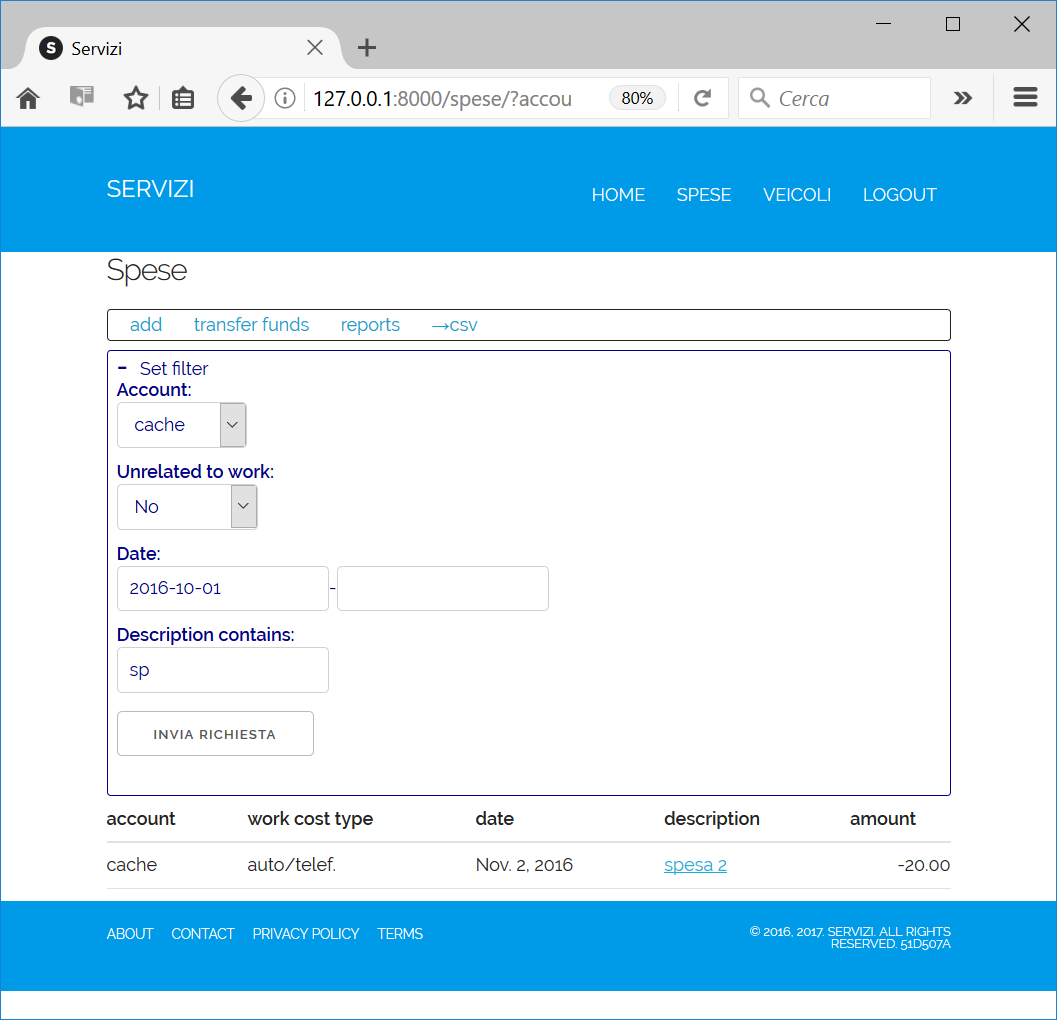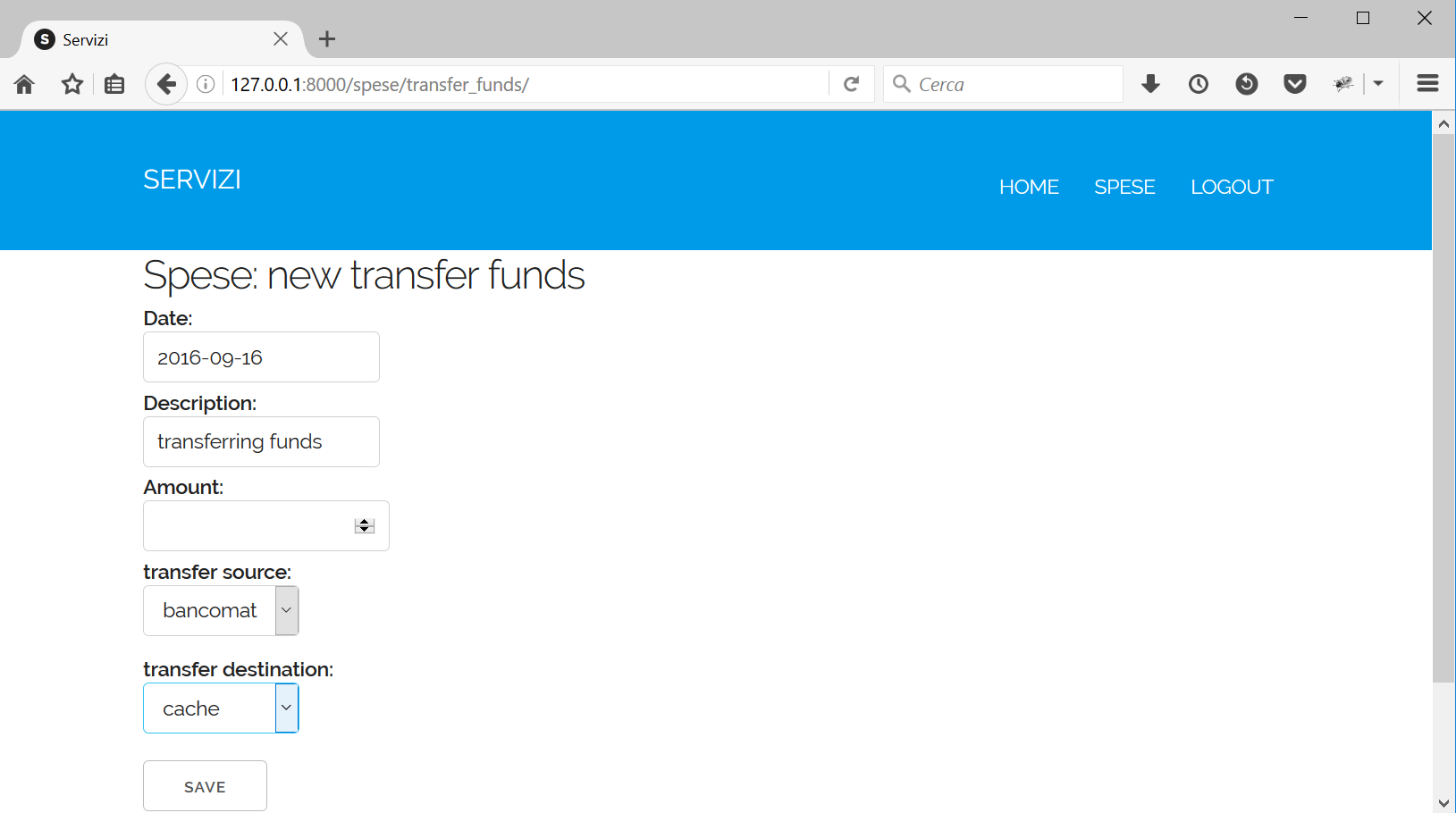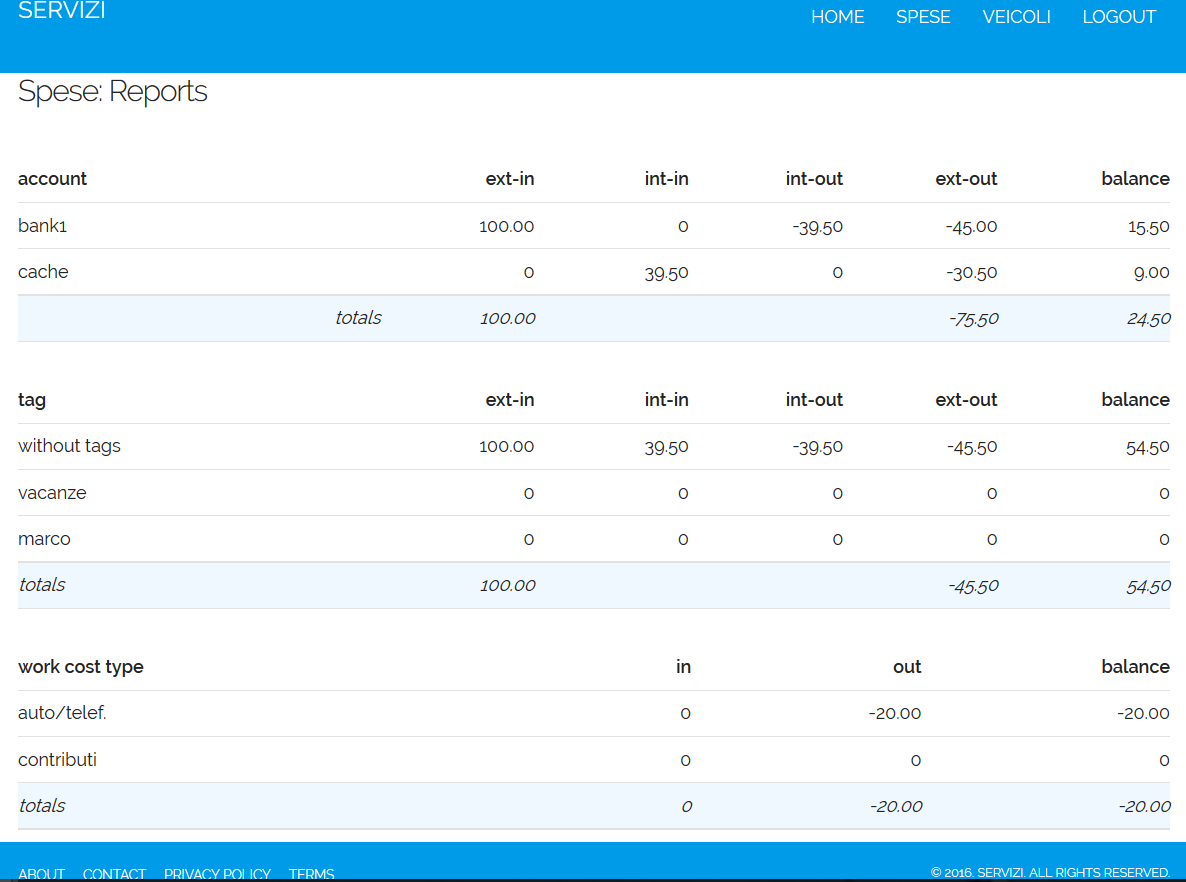User Guide¶
Here we are going to talk about how use django-spese to register our personal expenses.
To understand better the available operations, we need know the base concepts underlining this application. So first of all we’ll talk of General concepts.
Then we’ll see the Administration operations.
And finally we’ll see the details about Using it , where it means the application, of course.
Let’s start.
General concepts¶
Well, we said personal and expense. Two terms to think about.
Thinking to personal we get the first concept: every expense own someone.
Who is this one? The logged user.
Hence, to use django-spese we need login using a username
and a password. When we do it, the application will bind every
new expense to us.
Follow the second concept: I, logged user, can add and work on my expenses; but I cannot do something on somebody’s else expenses. Even I cannot see them.
Clarified the personal term implications, let’s see the expense term.
An expense means money to buy something. Where is money from?
Here we are at the third concept: in django-spese a source of money is called (bank) account.
An account could be a wallet, or a debit card, or a bank account or something else. Every expense is bound to an account from where money is kept to fulfil it.
Be aware do not confuse this account concept with idea of user. In django-spese when we speak about account we mean bank account, not user account.
As opposed from everyday world, here an account hasn’t limit: we can draw from it how much money as we wish. Or add to it.
Add? Yes, add. Why we could not add money instead of remove it? Forth concept: write positive numbers to add money to an account, and negative numbers to subtract money from it. django-money don’t know how to subtract money, it knows only how to add it :)
Fifth concept: an account is bound to one, or more, user(s).
This means that every user could have one or more account(s). But is also possible an account could be shared between two or more users. (Yes, I know. This is a very strange concept. Only the few married men can understand it :-)
Sixth concept: every expense could be classified using one or more tag(s).
For example, maybe I wish classify my holidays expenses using the tag freetime, and the work expenses assigning them the work tag.
A last concept and we’re done. Seventh concept: it is possible tranfer money from one account to another. We call this kind of operation: tranfer funds.
Using transfer funds we can save time. We could subtract (remember: use a negative number) from an account and add the same (positive) number to another account. But it’s a waste of time and it’s even a bit error prone: it isn’t so difficult write one of the two numbers with one more, or less, digit.
And, without transfer funds, if we need to change an amount, we must remember to change it in two (unrelated) expenses. transfer funds links the two exepenses, and if we change one, django-spese will change accordly the other.
Since a picture is worth a thousand words, to summarize, please look at the figure below, which sum up the relationships between the exposed concepts.
As we can see, the most complex relations are between account and user, and between tag and expense. Technically speaking, these are m:n relationships. Every account could belong to more users and vice versa. Similarly for tag and expense.
The relationships user / expense and source /expense are much simpler: one user own more expenses, not viceversa. So between source and expense.
Oh, I haven’t quoted the work cost type. Have I? Please, be patient. Over the seventh I tend to confuse between ordinals. So ... I explain it now. In case you are a professional, may be you wish to register work’s expenses. If so, you can classify this kind of costs assigning an appropriate type. WCType means Work Cost Type and register these types. And PercentDeduction register what percent can be deduct from income tax calculation about a type.
In case you are asking yourself why use records to register a percent deduction associated to a work cost type, the answer is: time. The percentage can vary on time passing, and we can register different values on different time intervals. Yes, incoming tax calculation isn’t a simple matter in Italy.
Oh! I was forgetting. In case of transfer funds, you cannot assign work cost type to the operation. Work cost type is worth about money flow to/from the extern boundary of our accounts. Not about internal movements between accounts.
Ok. Now our global knowledge about django-spese is complete. We can start play around.
Administration¶
django-spese administrators are in charge to supply a simple but complete environment to application users.
To accomplish this target you use the URI http://127.0.0.1:8000/admin/ and login using the administrator’s username and password.
Base administration window looks as below, without the ellipses:
Red ellipses show the most interesting entities for our duties:
- user,
- account,
- work cost type,
- percent deduction,
- and tag.
Green ellipses show the shortcuts to add and change the target records.
User interface is immediate, so I don’t explain it in detail. Only, I wish underline two points.
First. It isn’t possible to know an existing user password. We can only reset it to a known value. To do so, select user entity, from the next users list select the desidered user, and then use link underlined with red ellipse in the picture below.
Second. When working on accounts, remember: an account could be shared between different users. So the pertinent window looks like below:
Here red ellipse remember us the possibility to bind a single account to more users.
It’s important bind the account to the correct user, and be aware to share accounts that are truly shared between different users. I.e. let’s to keep again the previous picture. There we have wallet shared between user1 and user2. This means that this two users have the same wallet: see it as a shared wallet!
If I wish model a situation where user1 and user2 have different wallets, I must create them (for sake of example let’s say wallet1 and wallet2) and assign either of them to a single user (to complete the example: bind wallet1 to user1 and wallet2 to user2).
A last word about tags. These are the folders used to classify our expense. So I urge you to create a tag set limited in size, that fit well with your necessities. It’s a difficult matter change classification criterions while running :)
Using it¶
And now, provided of user’s username and password, finally we can login visiting http://127.0.0.1:8000/spese/.
Home page welcome us, showing the list of our expenses:
Hereafter we call this window as home, even if the true home is the project home. But we need to focus on our application, so we call home this one.
In the previous figure we highlight the presence of two different menues: the project menu and the the django-spese menu.
Project menu depends on your project. The previous figure shows the one you obtain from the django-spese repository. It’s there only as a demo to host our application.
We are concerned about the django-spese menu. At home we have this voices:
- add adding us a new expense;
- transfer funds to realize a transfer of money from one source to another;
- reports to show a summary about our tracked accounts and tags;
- →csv to export the showed expenses list to a csv file.
If we click on an expense description, we’ll get its detail:
and from there we can:
- add to insert a new expense (this is the same menu voice from home);
- change to edit the expense characteristics;
- toggle to change the amount sign of the expense;
- delete to remove the expense.
In case of a transfer between funds, its details view show us even a link to the associated transfer. In next picture this link is highlighted by the green oval.
If we wish to focus on a limited expenses list, we can use the filter section, located just below the django-spese menu. If we click on + Set filter the application will expand the filter section:

In this section we can choose to select our expenses:
- by account, selecting it using the first selection list;
- by relation with work, using the second selection list, titled unrelated to work; this list has three choises: unknown selects expenses of every type, yes selects only expenses with work cost type value unset, and no selects only expenses with a valid work cost type value set;
- by a date interval, using the two date fields;
- and, finally, by a piece of description, writing it in the last field of the section.
Filtering, all choosed values are used contemporary. I.e. if we choose account and description, this is exactly what we obtain: a list of expenses that satisfy both the criterions.
After we have compiled the filter fields, we need to click on the transmit request button to make effective our selections.
Hereafter I depict an example of use of filter, where we request to show only expenses:
- about cache account,
- and not related with work,
- and occurred after 1st october 2016,
- and with slice of word sp in description.

Be aware that clicking + Set filter and - Set filter we open, or close, the filter section. But values we set in it are valid anyway. To reset filter (by now) we must clear every value in it manually.
Adding expenses¶
At home, selecting the django-spese menu voice add we obtain a form to input an entirely new expense:
Here we can select the desidered account, write the date, description and amount. And we can choose between the showned tags to categorize our expense.
When we are done, we can save and return to home, using the save button. Or we can save and add again a new expense, using the save & continue button.
Using save & continue give us the current form already completed with the previous fields values. This is confortable in case of entry of more expenses regarding same account, close dates, same tags ...
To leave the form without creating a new expense, simply use the browser’s back button, or visit the home URL.
Changing expense¶
As we said, at home, selecting an expense, we obtain the expense detail window.
Here we can choose the change menu voice getting a form to change the expense characteristics:

In this form we can change whatever we wish. To save changes, we must push the save button, moving us to detail again. Or we can choose the save & continue button, that keep us on the current change form: just in case we wish change more fields values but one at time.
Toggling expense¶
From the detail window, we can choose the toggle menu voice.
If we hit this voice, the application change the sign of the amount of the displayed espense.
This action is immediatly shown. We can observe:
- a (hopefully) confirming message after the spese’s menu area;
- the new amount of the expense, with the same quantity, but opposite sign.
Deleting expense¶
In the expense detail window there is another, very dangerous, menu voice: delete.
As we can imagine, this voice remove the showed expense.
Warning
What you don’t know is that, by now, this operation don’t ask for confirmation.
If we choose to delete the current expense this is what we immediatly obtain.
Transfer funds¶
At home, selecting the django-spese menu voice transfer funds we obtain the shortcut to transfer money from an account to another:

As usual: we must compile the form with the appropiate values. Then choosing the save button we get the desired operation: the amount is subtracted from tranfer source and added to transfer destination.
Reports¶
At home, selecting the django-spese menu voice reports we obtain a summary about the current situation of the observed accounts, tags, and work cost types:

Just a note. Remeber that reports works using the filter set in spese home. So reports are homogeneous with expenses list.
Now, we spend a word about the overall layout of these reports.
First of all: the window has three tables:
- about accounts;
- about tags;
- and about work cost types.
Every row of accounts and tags is divided in six columns. From left to right:
- the item name;
- the sum of the income from the extern, i.e. not from transfer funds operations;
- the sum of internal income, i.e. from transfer funds operations;
- the sum of internal outcome, i.e. transfer funds operations to other accounts;
- the sum of outcome to the extern, i.e. not transfer funds to other accounts;
- and finally the sum of hte previous quantities: the balance of the row.
In case of work cost types, are missing the columns about transfer funds because here we observe money flow from/to our system boundaries.
The last row of every table shows the relative column grand total, with the exceptions of the transfer funds columns that aren’t calculated.
→csv¶
Clicking this menu voice we export the showed expenses list to a file named expense_list.csv located in the download directory of our web browser.